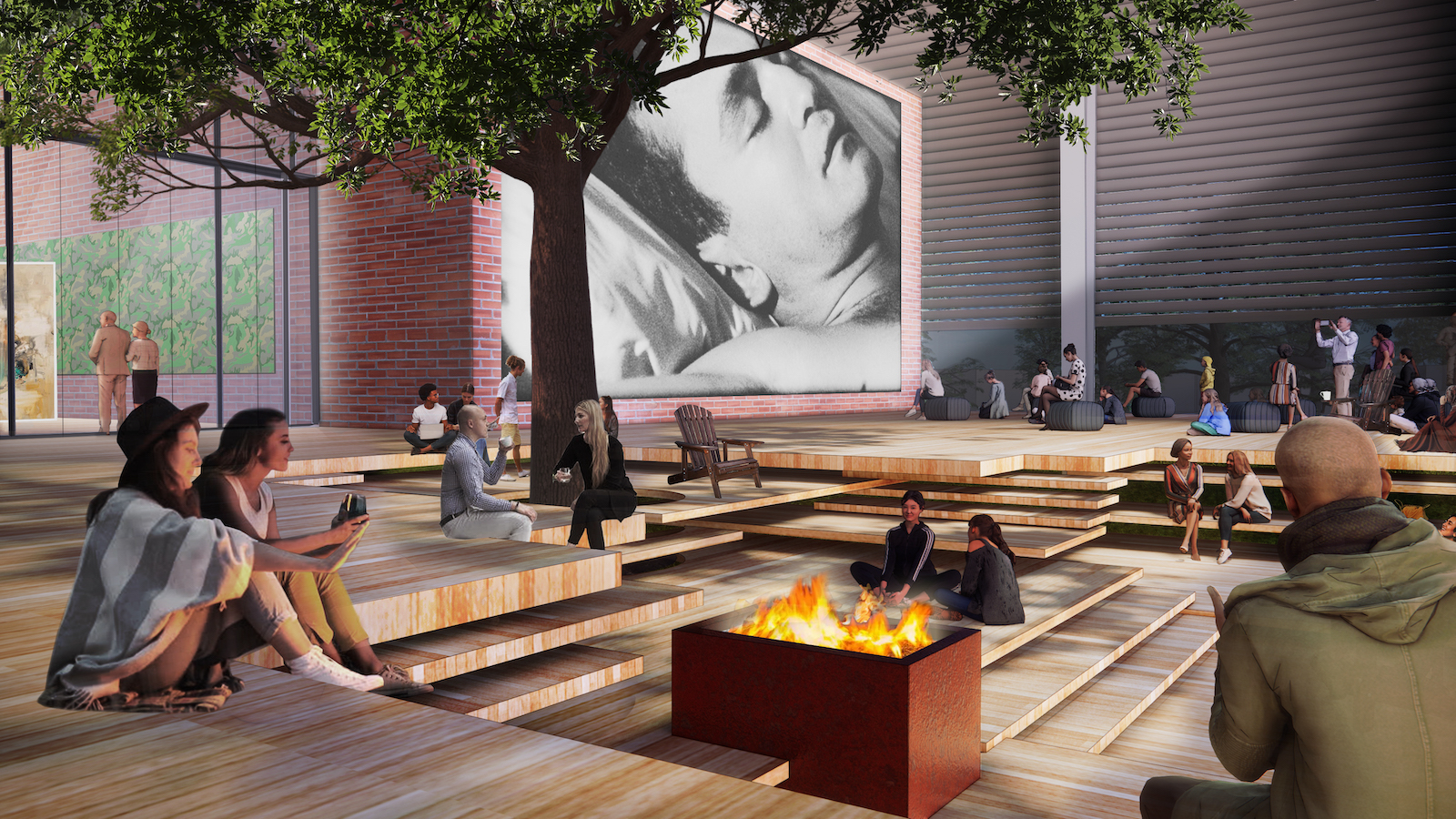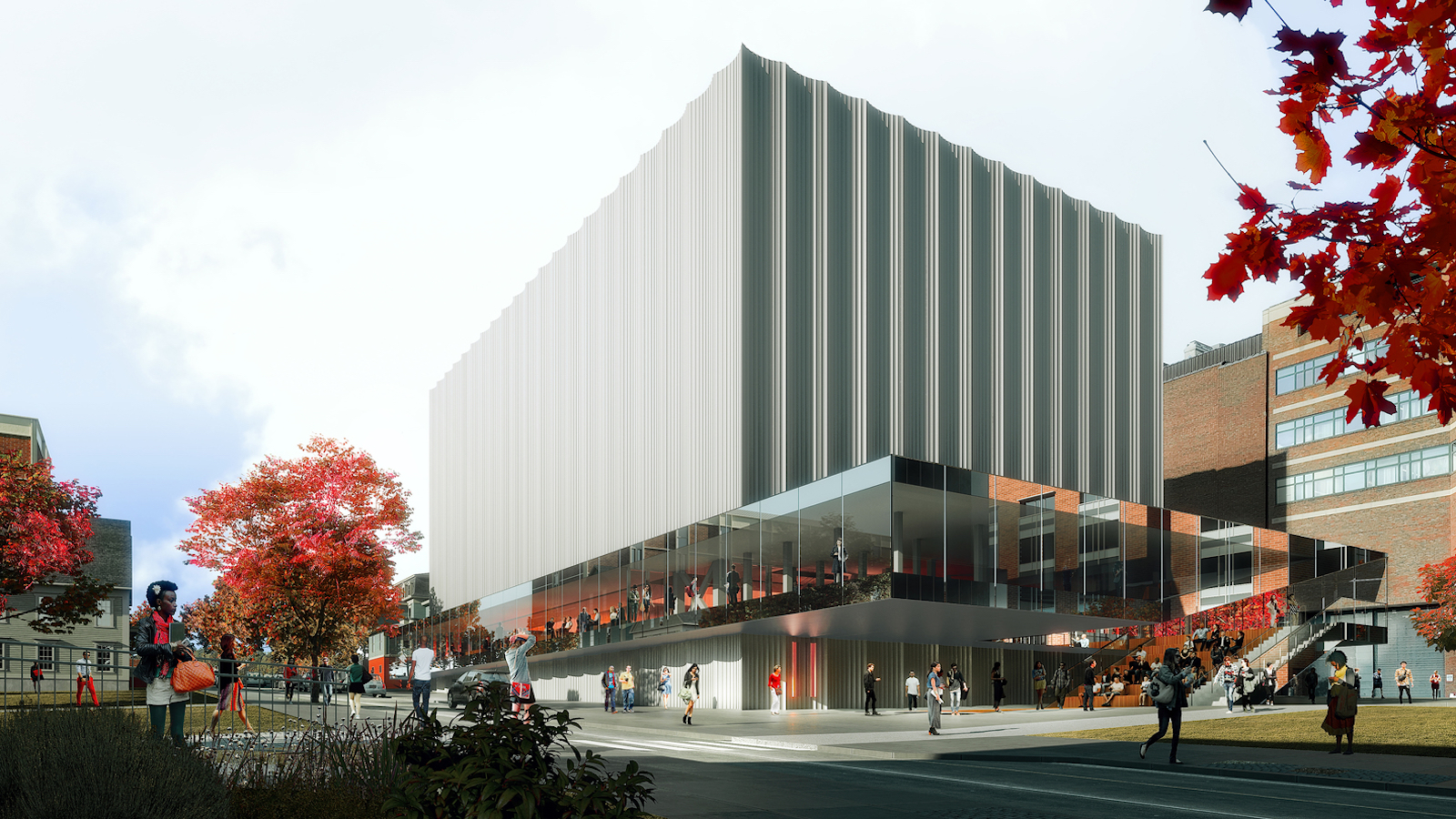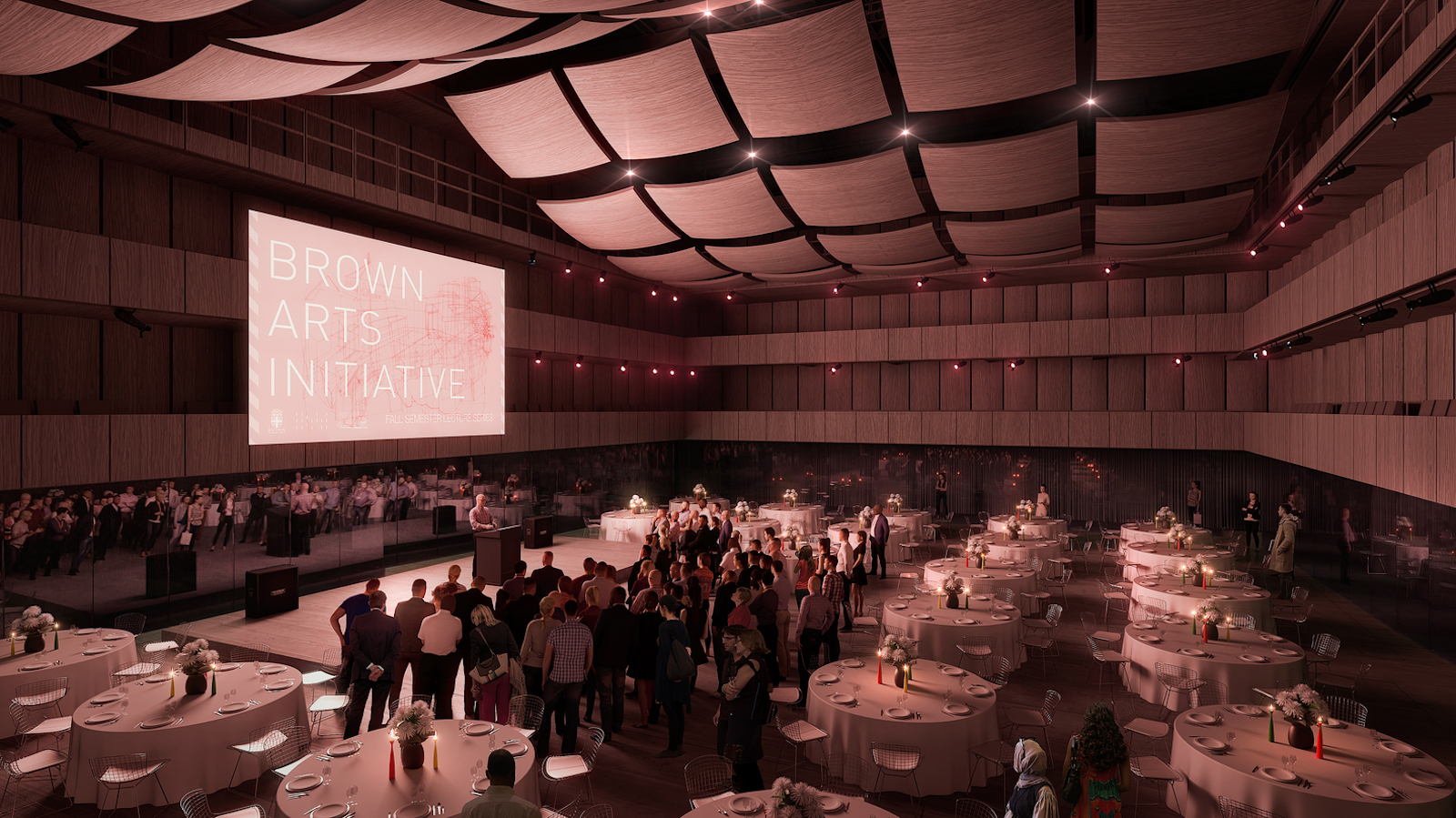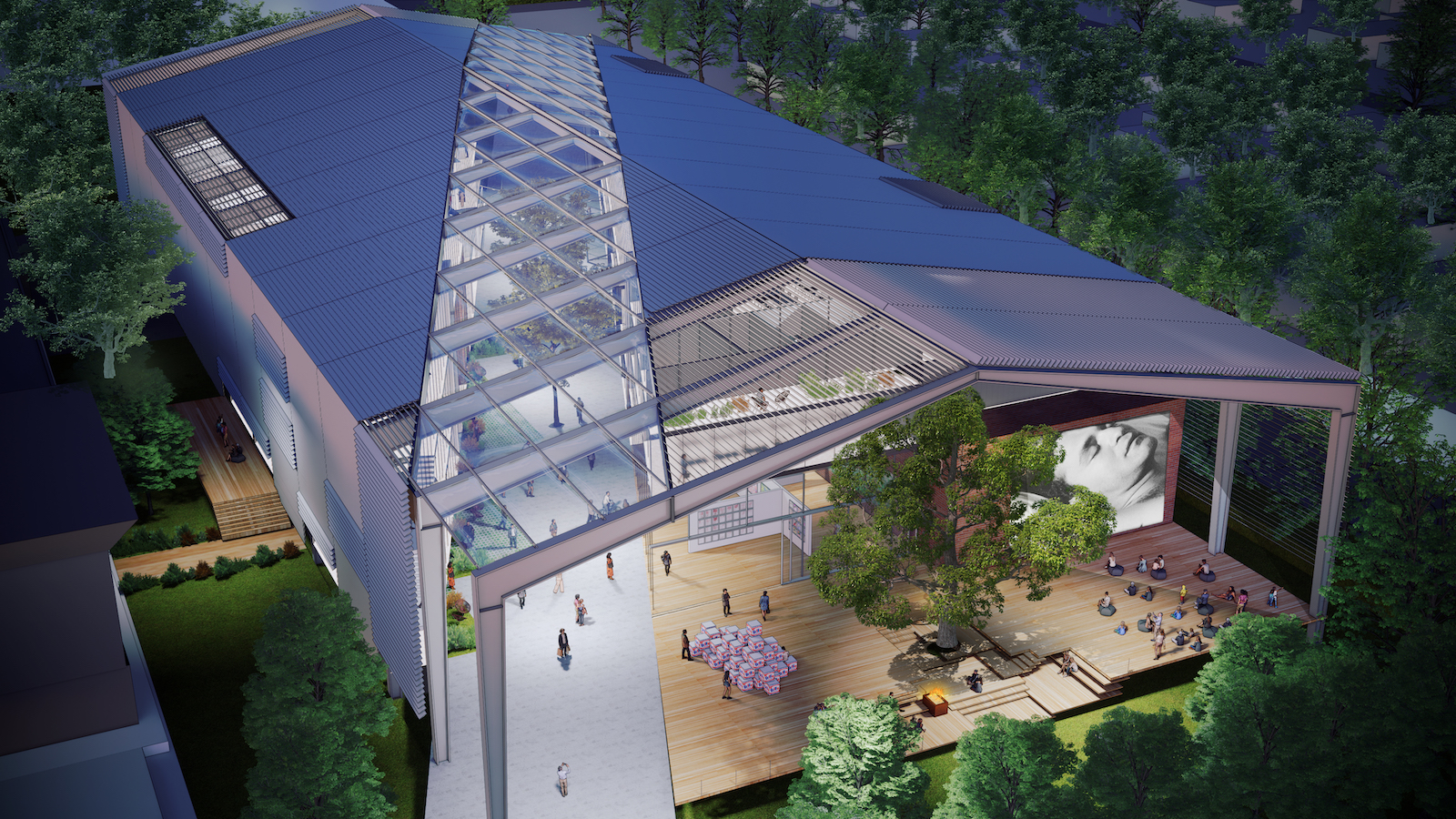A decade or so ago, Voith & Mactavish Architects was doing a lot of performing arts center design for independent secondary and prep schools. “In some ways, higher ed is now catching up” with the expectations of students, explains Daniela Voith, VMA’s Founding Partner and Director of Design, about cultural-related projects her firm has done for universities and colleges lately.
One recent example was the $60 million, 84,000-sf John and Joan Mullen Center for the Performing Arts at Villanova University in Pennsylvania. The LEED Silver-certified building, which was completed in the spring of 2020, is part of a major capital campaign to redevelop the campus’s southern area. The center features two theaters, with 400 and 200 seats respectively, and a 75-seat performance lab. VMA collaborated with Robert A.M. Stern Architects on the art center’s design. Bala Engineering, O’Donnell & Naccarato, and Nave Newell were the project’s engineers, and LF Driscoll provided construction management. The General Building Contractors Association bestowed its 2020 Best Cultural Institution Project Award on this arts center.

Voith isn’t alone in her belief that there’s a renewed recognition among universities that art and creativity “are part and parcel with what makes America succeed.” She also thinks that new and renovated arts centers can be weapons in the “arms race” being waged by universities and colleges that are raising their facilities and amenities to state-of-the-art levels to lure and retain students and faculty.
It might also be a coincidence, but several high-profile arts-related projects are in various stages of development or completion at a time when college enrollment in the U.S. in 2021 dropped for the second straight year, according to recent data from the National Student Clearinghouse Research Center, which estimates that enrollment was down 6.5 percent from pre-pandemic levels.
Integrating Arts And Education in Higher Education

In December, Princeton University in New Jersey—which, in truth, has no trouble attracting student applicants—started construction on its new Art Museum, which at 144,000 sf doubles the size of the museum it is replacing. Designed by Adjaye Associates in collaboration with Cooper Robertson, the three-story Princeton University Art Museum will be a grid of nine pavilions showcasing selections from the museum’s expansive and growing collection, which numbers more than 112,000 items. The building will also house Princeton’s Department of Art and Archeology, and Marquand Library. James Corner Field Operations is the project’s landscape architect, and LF Driscoll provided pre-construction services. The museum is scheduled for completion in 2024. In the interim, the museum will operate two gallery spaces in downtown Princeton, and is planning two outdoor exhibit spaces.
That same month, on December 10, a building team led by the construction management firm Shawmut Design and Construction and the architecture firm REX, celebrated a virtual topping off of Brown University’s 94,000-sf Performing Arts Center, which is scheduled for completion in the spring of 2023, and is utilizing integrated project delivery that incorporates subcontractors and the university into all phases of the project.
The vision for this PAC supports Brown’s 10-year strategic plan, Building on Distinction: A New Plan for Brown (2013), which commits the university to integrative scholarship, educational leadership, academic excellence, and campus development. “Brown is committed to the full integration of the arts into a complete liberal arts education,” the university states on its website. “We know that addressing some of the world’s most vexing challenges benefits from the creative problem-solving enabled by people who have studied and experienced the arts.”
The performing arts center will anchor a future arts district on Brown’s campus in Providence, R.I. Its main performance hall will feature five radically different preset spatial, acoustic, and technical configurations, from a 625-seat symphony orchestra to a 250-seat proscenium theater; as well as three smaller performance and rehearsal spaces below street level where students and faculty can create art works collaboratively. The building’s exterior aluminum rainscreen will appear to shift in color and pattern with time-of-day and seasonal changes.
The performing arts center project is anticipated to achieve a minimum of LEED silver certification. (Brown’s stated policy is not to release cost information until a project is completed.)
Recalling the Past, Without the Obsolescence

Another arts education project that’s drawn attention is Diller Scofidio + Renfro’s (DS+R) design for the Susan and Fayez Sarofim Hall, a $25 million, 50,000-sf building for visual and dramatic arts students, situated on the Houston campus of Rice University. Sarofim Hall, which is scheduled to break ground this year and be completed in 2024, will add to Rice’s already vibrant cultural district that includes the Moody Center for the Arts (which opened in 2017), the newly constructed Brockman Hall for Opera, and Shepherd School of Music’s Alice Pratt Brown Hall.
Rice’s Visual and Dramatic Arts department is one of the university’s most popular, with 900 students per year.
“Cross-disciplinary discourse is a hallmark of the arts in the 21st century, but it has been difficult at Rice since its facilities are scattered all over campus,” observes Charles Renfro, a Partner at DS+R and a Rice graduate. “Sarofim Hall will not only bring these programs together for the first time, but also facilitate experimentation and collaboration between disciplines through open, transparent, indoor/outdoor and public-facing space.”
DS+R’s design recalls the campus’s now-defunct Art Barn and Rice Media Center, which date back to the late 1960s, and the mass-produced pre-engineered metal structures that were popular after World War II. (Art Barn, which was officially known as the Institute for the Arts, was torn down in 2014, and The Media Center is being razed to make way for Sarofim Hall.)
The prefabricated Sarofim Hall will incorporate exhibition areas, labs, studios, shops, faculty offices, and other collaborative spaces for artists across all media. The building’s design frees the steel frame from its skin, and blurs the boundaries between maker and exhibition spaces.
The studios and facilities are designed to guard against obsolescence by encouraging students to fashion their work areas according to their artistic needs. “The building shell is thought of as a piece of infrastructure: simple, durable, and timeless, while the insides can transform as needs change,” Renfro is quoted as saying.
Sarofim Hall’s distinguishing characteristics include Art Street, a glass-lined walkway that cuts diagonally through the four-story building and will serve as a new entrance to the university; and West Porch, a covered outdoor area for such programming as classes, exhibits, and film screenings.
“DS+R’s initial concept for the new building cleverly weaves the symbolism of that history with the scale, materiality, and ‘porosity ’of the broader campus fabric,” adds University Architect George Ristow. “With the building being at the outward-facing perimeter—and at an entrance into campus that has evolved into one of the most active and dynamic access points—it will undoubtedly have a different kind of visibility beyond the hedges that will be leveraged as a new and unique gateway to the Rice arts corridor.”
The project team for Sarofim Hall includes Jackson & Ryan Architects (executive architect), OJB Landscape Architecture (LA), Fisher Dachs Associates (theater consultant), Threshold (acoustics/AV), Martinez Moore (SE), Walter P Moore (CE), and Wylie Associates (MEP). The university did not identify the project’s construction manager or general contractor.
Related Stories
| Nov 9, 2010
Just how green is that college campus?
The College Sustainability Report Card 2011 evaluated colleges and universities in the U.S. and Canada with the 300 largest endowments—plus 22 others that asked to be included in the GreenReportCard.org study—on nine categories, including climate change, energy use, green building, and investment priorities. More than half (56%) earned a B or better, but 6% got a D. Can you guess which is the greenest of these: UC San Diego, Dickinson College, University of Calgary, and Dartmouth? Hint: The Red Devil has turned green.
| Nov 9, 2010
Designing a library? Don’t focus on books
How do you design a library when print books are no longer its core business? Turn them into massive study halls. That’s what designers did at the University of Amsterdam, where they transformed the existing 27,000-sf library into a study center—without any visible books. About 2,000 students visit the facility daily and encounter workspaces instead of stacks.
| Nov 3, 2010
First of three green labs opens at Iowa State University
Designed by ZGF Architects, in association with OPN Architects, the Biorenewable Research Laboratory on the Ames campus of Iowa State University is the first of three projects completed as part of the school’s Biorenewables Complex. The 71,800-sf LEED Gold project is one of three wings that will make up the 210,000-sf complex.
| Nov 3, 2010
Seattle University’s expanded library trying for LEED Gold
Pfeiffer Partners Architects, in collaboration with Mithun Architects, programmed, planned, and designed the $55 million renovation and expansion of Lemieux Library and McGoldrick Learning Commons at Seattle University. The LEED-Gold-designed facility’s green features include daylighting, sustainable and recycled materials, and a rain garden.
| Nov 3, 2010
Recreation center targets student health, earns LEED Platinum
Not only is the student recreation center at the University of Arizona, Tucson, the hub of student life but its new 54,000-sf addition is also super-green, having recently attained LEED Platinum certification.
| Nov 3, 2010
Virginia biofuel research center moving along
The Sustainable Energy Technology Center has broken ground in October on the Danville, Va., campus of the Institute for Advanced Learning and Research. The 25,000-sf facility will be used to develop enhanced bio-based fuels, and will house research laboratories, support labs, graduate student research space, and faculty offices. Rainwater harvesting, a vegetated roof, low-VOC and recycled materials, photovoltaic panels, high-efficiency plumbing fixtures and water-saving systems, and LED light fixtures will be deployed. Dewberry served as lead architect, with Lord Aeck & Sargent serving as laboratory designer and sustainability consultant. Perigon Engineering consulted on high-bay process labs. New Atlantic Contracting is building the facility.
| Nov 3, 2010
Dining center cooks up LEED Platinum rating
Students at Bowling Green State University in Ohio will be eating in a new LEED Platinum multiuse dining center next fall. The 30,000-sf McDonald Dining Center will have a 700-seat main dining room, a quick-service restaurant, retail space, and multiple areas for students to gather inside and out, including a fire pit and several patios—one of them on the rooftop.
| Nov 1, 2010
John Pearce: First thing I tell designers: Do your homework!
John Pearce, FAIA, University Architect at Duke University, Durham, N.C., tells BD+C’s Robert Cassidy about the school’s construction plans and sustainability efforts, how to land work at Duke, and why he’s proceeding with caution when it comes to BIM.
| Oct 13, 2010
Editorial
The AEC industry shares a widespread obsession with the new. New is fresh. New is youthful. New is cool. But “old” or “slightly used” can be financially profitable and professionally rewarding, too.
| Oct 13, 2010
Campus building gives students a taste of the business world
William R. Hough Hall is the new home of the Warrington College of Business Administration at the University of Florida in Gainesville. The $17.6 million, 70,000-sf building gives students access to the latest technology, including a lab that simulates the stock exchange.















